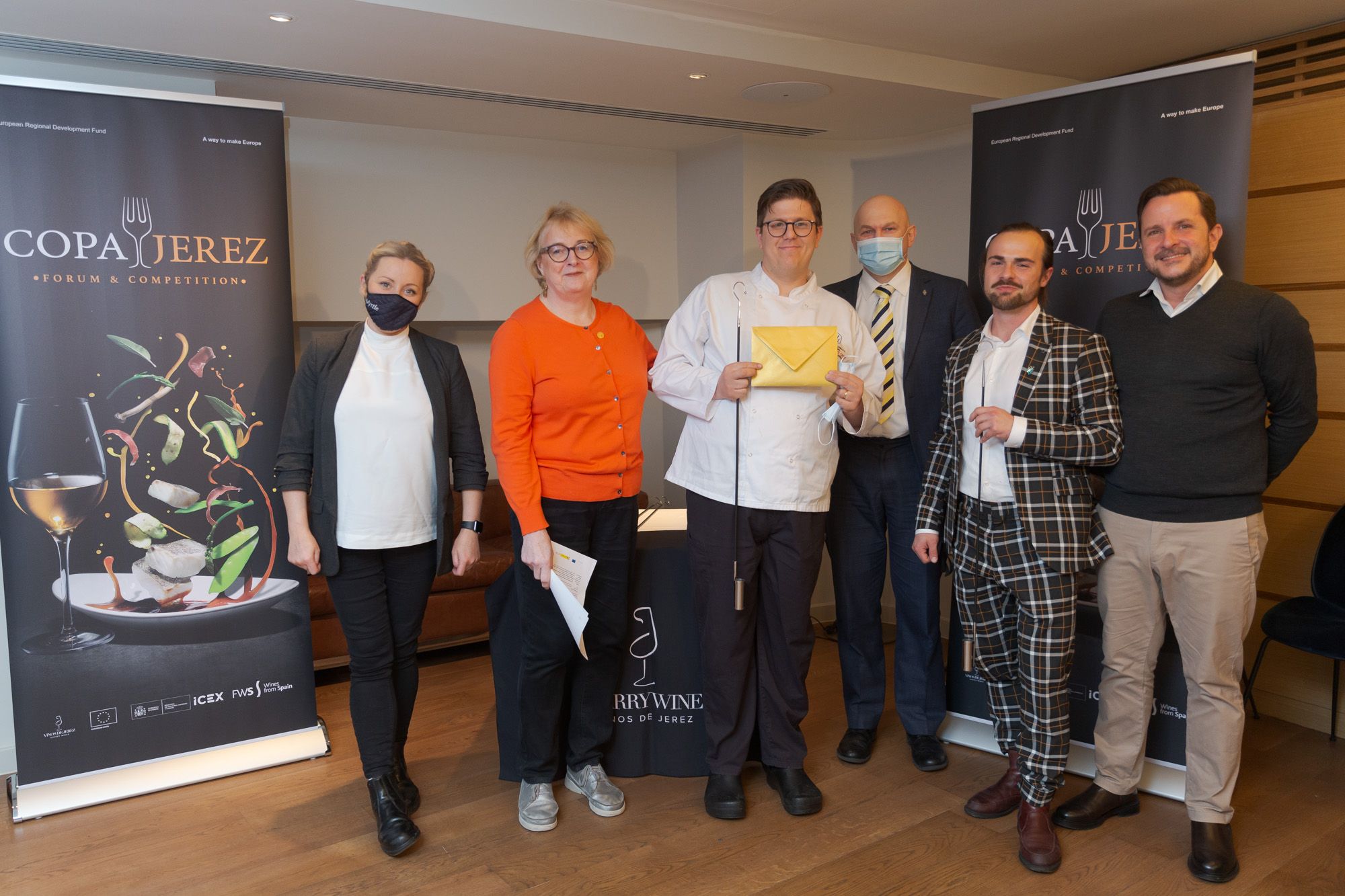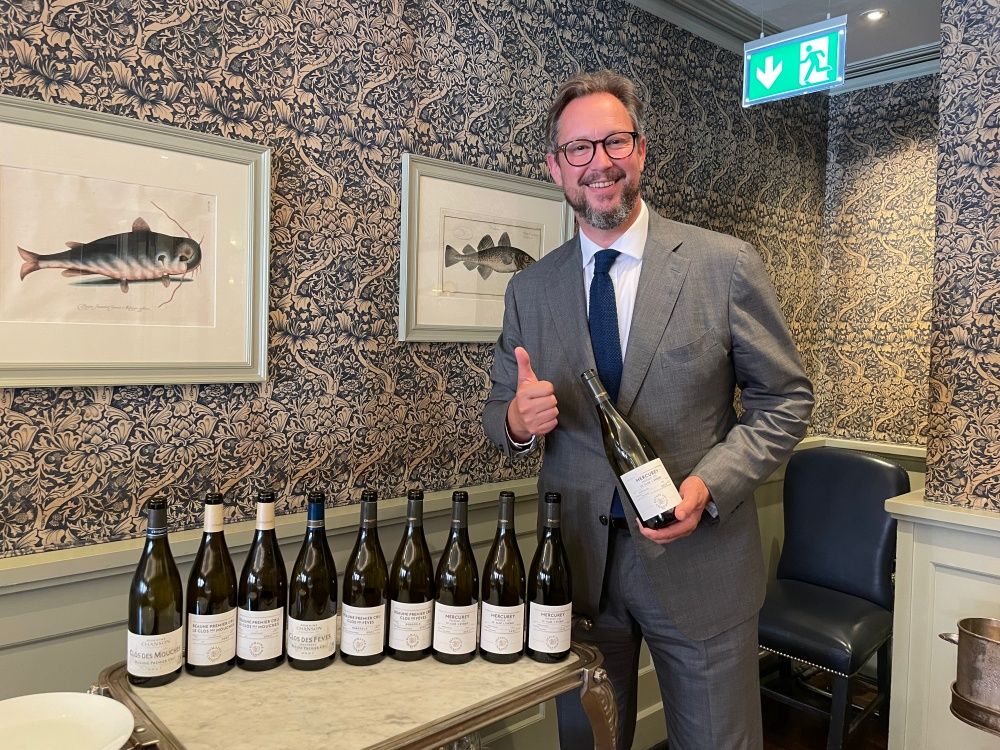The River Café team will compete in the Copa Jerez international final with winning teams from heats that have also taken place in Belgium, Denmark, Germany, the Netherlands, Russia, the United States and Spain.
Sherry has long been used by chefs as one of the most versatile drinks to use not just in their recipes but as a perfect pairing when served to their customers. Which is very much what the Copa Jerez competition is all about.
The chance for chef and sommelier teams from some of the world’s most famous restaurants to come together and create a three course meal that showcases the very best of what sherry can offer to bring out flavours and texture in different styles of food, using a wide range of ingredients.
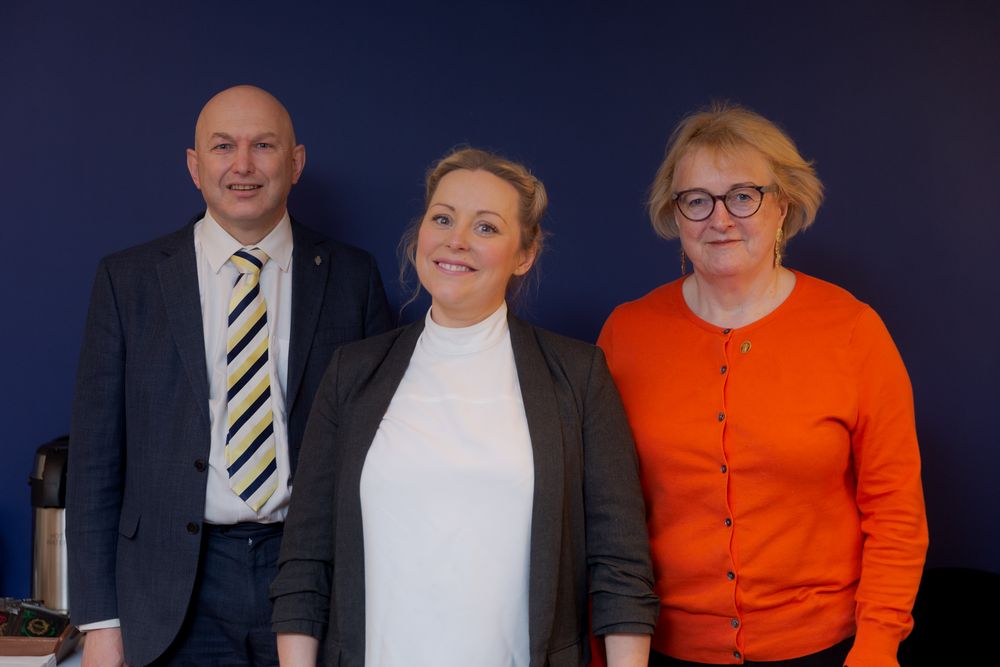
The Copa Jerez UK judging team with Matthieu Longuere MS, Anna Haugh and Sarah Jane Evans MW. They were joined by Fernando Muñoz Naranjo, director at Foods & Wines from Spain in handing out the awards. Photos by Tucker Images
The UK competition, held at Le Cordon Bleu’s new Cord restaurant in central London on May 24, 2021, was once again hotly contested with teams applying from around the country. In the end the judging panel made up of chair, Sarah Jane Evans MW along with sommelier judge, Matthieu Longuère MS and chef judge, Anna Haugh, owner of Myrtle restaurant in London, were able to assess the dishes and pairings created by the three teams in the UK final. They were helped on the day by Fernando Muñoz Naranjo, director at Foods & Wines from Spain.
Haugh shared her own experiences of the event: “Since I competed in Copa Jerez in 2016 the competition has changed so much. It is amazing, the standard of cookery and food pairing menus with sherry is so high.” She added: “They say the taste of sherry is the taste of anticipation, and you can definitely taste that here today.”
As well as the winning menu from the River Café (see below) the judges were particularly impressed by the ‘Chocolate Mousse, Vanilla and Hazelnut Praline’ dessert prepared by chef Ian Musgrave, paired with a Cream Sherry by sommelier Arturo Scamardella from The Ritz who were placed third in the competition. Then in second place was chef Scott HuntMcDonnell and sommelier Julio Tauste, who received particular praise for their ‘Mackerel Tartare, Granny Smith Apple, Cucumber, Oyster leaf, Caviar’ which was paired with Bodegas La Riva Manzanilla Fina Pago Miraflores.
Here Sarah Jane Evans MW explains what it was the judges were looking for in the food and wine pairings.
Can you tell us why you wanted to be involved in the Copa Jerez competition?

Sarah Jane Evans MW was bowled over the standard of the Copa Jerez competition
“It’s an absolute joy to be involved in this. It’s one of, or maybe the best food/wine pairing competitions there is in the UK. Simply, from the one grape variety Palomino you can get so many styles, so distinctly attached to that one region, those soils, that climate. There is a little Pedro Ximenez, and Moscatel, but this is basically a Palomino-fest. So we have the diversity of the wines, and then their superb flexibility in food matching. It means that the chefs can be super creative. And it has to be teamwork – the sommeliers really do have to work with the chefs and showcase their tasting skills.
Finally and importantly I was lucky enough to be one of the panel of five judges at Copa Jerez itself in Jerez in 2019. The chair of the judges is Josep (‘Pitu’) Roca of El Celler de Can Roca, and it’s really a treat to be able to listen to him and share thoughts with him. The standard was exceptionally high – between the seven restaurants competing from seven countries there were eight Michelin stars. The winner had an outstanding dessert – caramelised banana ice cream, with liquorice, olive and coffee sauce, matched to Bodegas Tradicion VOS PX. Astonishing – and fabulous. So we know the competition will be tough this year.
What did you think of the overall standard of entries?
Like so many of the competitions, just like eg Masterchef, the standard keeps on getting higher. But the style of cooking changes, it reflects the changing approach to cuisine in London’s restaurants. Even the most classical restaurants are not so rigid, the ingredients are more diverse in origin.
What was it about the three teams that went to the final that stood out for you?
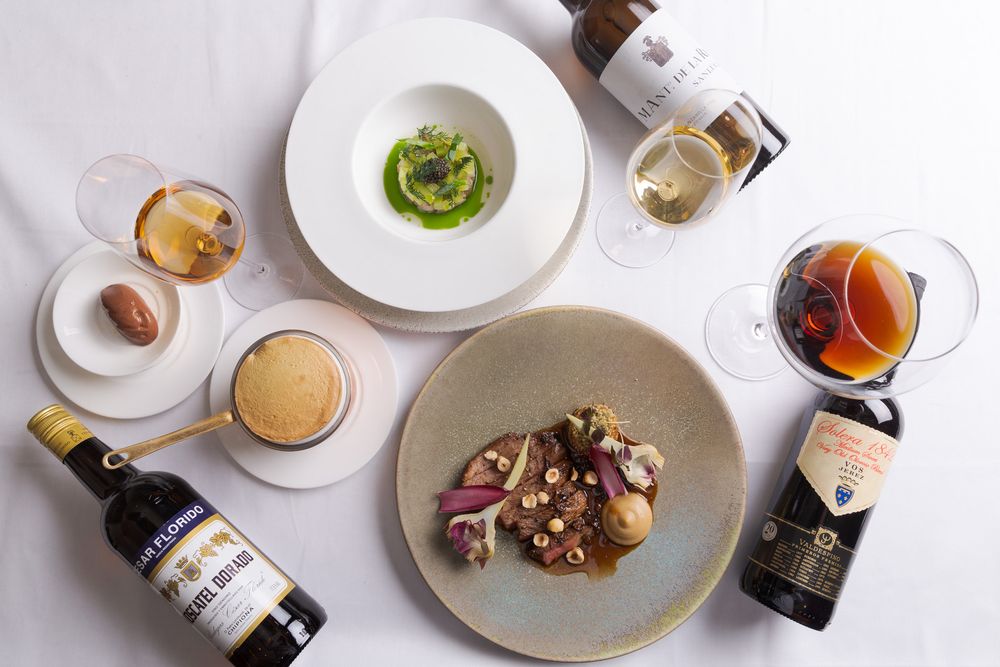
The three dishes devised by the team from The Orrery that came in second in the UK competition
Actually I was looking to be challenged and that’s what was so appealing about the winning menu.
The Orrery team were very thoughtful and intelligent in their wine choice, and gave us a menu that showcased the three different grape varieties. Their starter was super-fresh. The Ritz piece de resistance was its Amedei chocolate mousse, a smart match to the Gonzalez Byass 1847 Cream. The River Cafe’s menu looked as if it was going to be quite straightforward, rustic, family cooking. But it was so much more.
What were you most looking for in the entries in order to be able to judge between the teams?
What’s very important is the whole package, the way the chef and sommelier work together, the teamwork and mutual respect they show, the way the sommelier presents the wines, and all the details down to the choice of glasses, and temperature of the wine.
What was it about the River Café entry that made it stand out from the rest?
The Antipasto, of butterbean soup with mussels and Guanciale was fabulous, melting, warming, traditional and a brilliant match to the ‘I think’ Equipo Navazos Manzanilla. The Smoked Lamb rack was a clever idea with the charred artichokes for the Secondo to highlight the character of the 12 year old Amontillado from El Maestro Sierra. Finally the Sbrisolona was a glorious not too sweet cake, something Italy does so well, and a perfect match to the Apostoles Palo Cortado from Gonzalez Byass.

The winning duo from the River Cafe, sommelier Mattia Mazzi and and freelance chef Vincenzo Raffone
Mattia Mazzi and Vincenzo Raffone were also a great pairing, and their friendship will stand them in good stead with the pressures of the finals. These are staged in a charming theatre in Jerez. But it’s intimidating cooking in a small space with the others and then presenting in front of the auditorium and the other chefs.
From your own experience why do you think sherry is such a versatile style of drink to create dishes with?
A dry Sherry is supremely appetising, at all times of day. Obviously there is a huge diversity, ideal for a sommelier, But the great thing is it matches every awkward dish you can think of – eggs, artichokes, you name it.
Matthieu Longeure MS, wine development manager at Le Cordon Bleu

Matthieu Longuere MS says he was particularly looking at how well the chef and sommelier team worked together
Can you tell us why you wanted to be involved in the Copa Jerez competition?
Sherry is a great wine, and the Copa Jerez is really a fantastic tool to promote all of the different categories to a broader audience. It is important to pass on the message to consumers that there is life beyond the Manzanilla and Fino drunk with tapas or Granny’s Cream Sherry (no offence). The Copa Jerez showcases the versatility of pairing Amontillados, Olorosos, Palo Cortados and Pedro Ximenez with the whole meal, which is great.
What did you think of the overall standard of entries?
It was the first time I had chance to judge, but I thought the standard was high, which was to be expected, considering the experience of the teams competing.
What was it about the three teams that went to the final that stood out for you?
They all gave a lot of thought about the perfect pairing and were willing to experiment. They did not hesitate to decant some of the older sherries or use a different glass shape to help the wine open up, or showcase the complexity of the rancio aroma. The use of Burgundy/Globe shape glass with VORS sherries was a revelation.
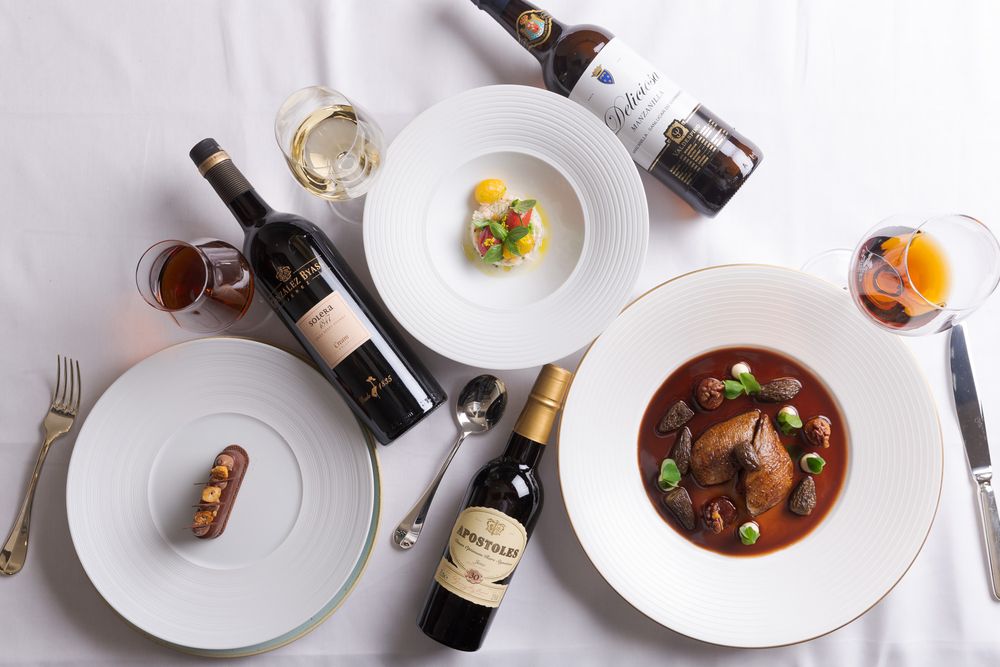
The menu from the team at the Ritz
What were you most looking for in the entries in order to be able to judge between the teams?
I was looking for a choice that fits with the philosophy of the restaurants they represent. The team work was very important. We should not feel that the chef or a sommelier has the greater influence over a pairing. We were expecting both the chef and the sommelier to present and justify the pairing. It was very obvious when the pairing was not selected democratically but imposed by a member of the pair.
What was it about the River Café entry that made it stand out from the rest?
They worked well together. It was very obvious that they were friends outside of work and it created a chemistry of comfort that did not exist with the other teams. This pair did not try to impress us as a jury, but instead treated us like real customers. I have entered and judged my fair share of sommelier competitions and sometimes the candidates try too hard, to the point that you know that you would never get the same experience if you were eating in their restaurant. I did not get that from the River Café team.
Their choices were efficient, and tried to spark the guests’ interest in sherry rather that assuming they loved sherry in the first place. I think they really understood the purpose of this competition.
Winning Food and Wine Pairing
The River Café
Vincenzo Raffone, freelance chef and sommelier, Mattia Mazzi.
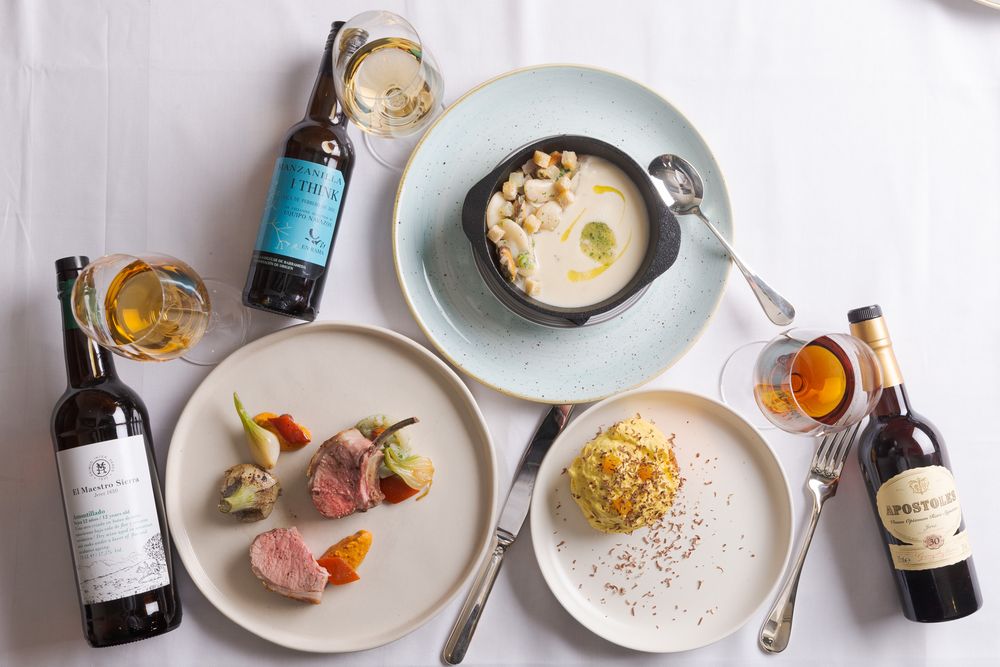
The winning three courses from The River Café
Here the winning duo explain the concept behind their winning food and wine pairing:
“Our pairing represents the ease in which an everyday patron could enjoy and understand a classic duet of sherry and authentic Spanish cuisine. This pairing is both affordable and inspired in its creative curation of flavours and textures. We take a classic method of combination and flip it on its head by starting with a wine and building a dish around it. By doing this we ensure that the intense flavour of sherry is complemented by a delicious but easy to prepare dish which is in no way lacking in panache.”
First course
Butterbean soup with mussels and Guanciale casserole
Paired with I Think Manzanilla, Equipo Navazos
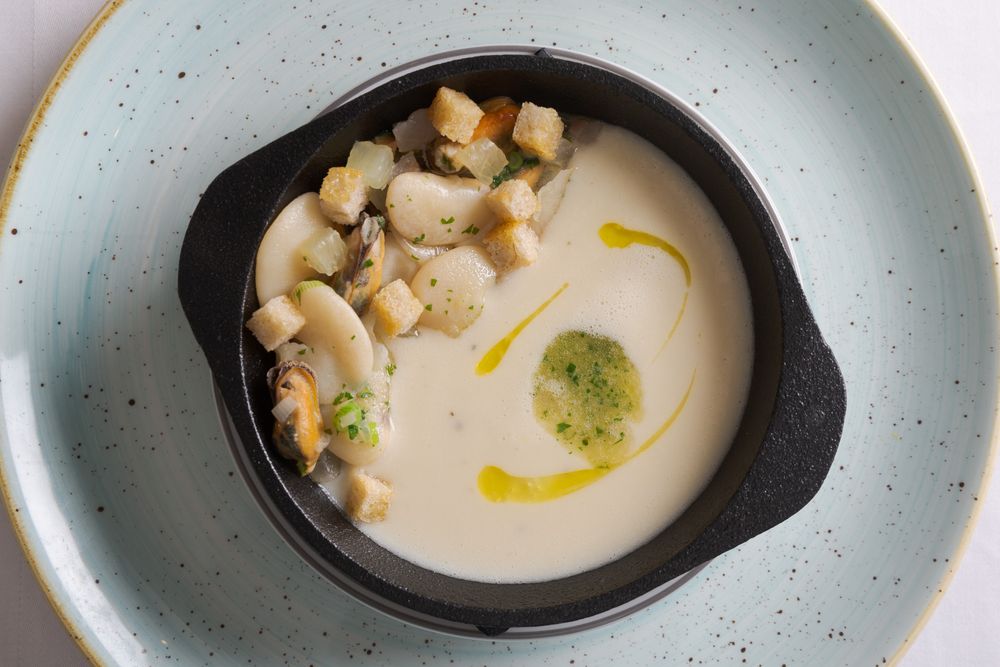
Here the idea was to match the saline but light notes of the deep sherry, balancing its alcohol content by the richness of the fat, allowing the salty notes in the wine to come through and perfectly compliment the seafood dish.
Method
Soak some butterbeans overnight and then cook in salted water until soft. Sweat some in some olive oil and then add to the strained beans, along with vegetable stock and a bay leaf and cook for 10-15 min. Strain the beans, leaving some liquid for the mussel casserole and bland the rest with the cooking liquor to the right consistency. Then sweat some guanciale in olive oil, adding mussels, some parsley stalks and deglaze with the wine. Cover the mussels with a lid and cook for a few minutes. When open, clean the mussels and put the meat back together with the guanciale.
Second Course
Smoked lamb rack, charred artichokes and Romesco sauce
Paired with Il Maestro Sierra Amontillado, 12 year old

“Here the idea was to bring out the intense smoky flavour in the lamb so that it “plays with flavours of umami in the Amontillado, and bitterness in the artichokes to create something truly special”.
Method
To do that place the lamb rack in a sealed bowl, and smoke using a smoking machine for around 60 seconds. Then sear the lamb in a pan with hot olive oil, and finish in the oven until the meat is pink.
To make the Romesco sauce you blow torch a Romano pepper and remove the skin. Dice the pepper and sweat it with some sliced garlic. Add warm nuts and cook for other two to three minutes and then cover with vegetable stock. Cook for another 15 minutes and then bland it. Peel, dice and soft boil some artichokes and when strained crush with the back of a fork and season with olive oil and lemon juice. Clean and pan fry an artichoke in oil and then after five minutes add some rosemary and deglaze with the wine and cover to finish off.
Third Course
Sbrisolona with spiced crema Catalana and orange compote
Paired with Apostoles 30-year-old Palo Cortado Sherry, Gonzalez-Byass
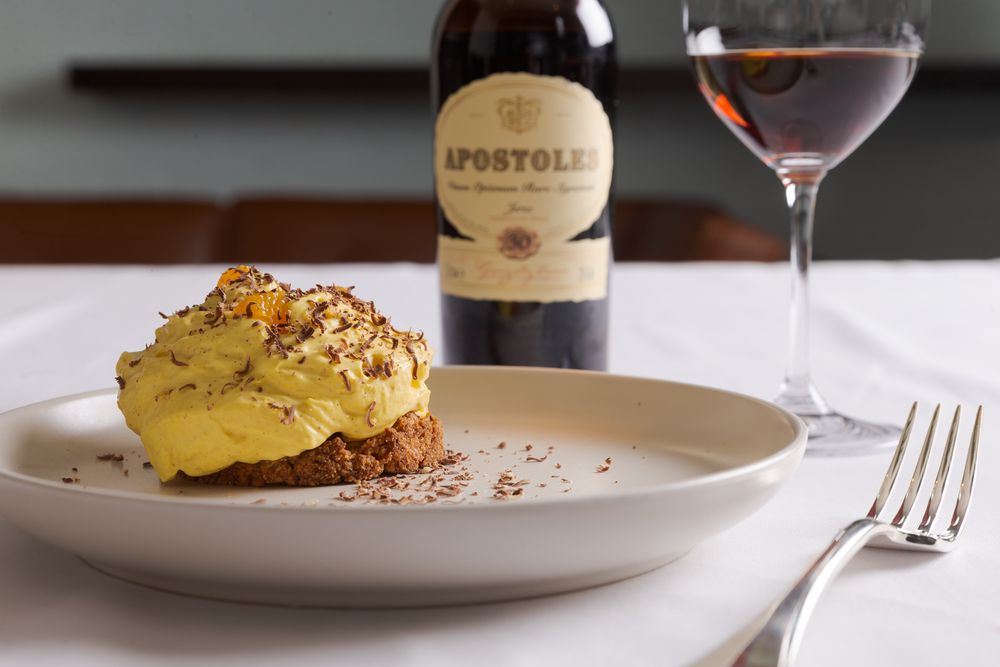
“When preparing this selection, we took care in ensuring the sbrisolona is balanced in its sugar content and savoury spices. By doing this we take an unorthodox approach in that a dry wine is used with a dry pudding. However, our break from traditionality makes way for a special and original finale.”
Method
Bland almonds with sugar until it turns to a powder, and then in a mixer combine it with a range of ingredients including vanilla bean extract, lemon zest, cornflour and butter and start to mix. Add the butter in small cubes and at the end an egg yolk. Place the mix in a cake mold and cook for 20-25min at 180c. Then put the cream and milk in a pot and bring to a simmer with cinnamon powder, nutmeg, saffron and cardamon, vanilla extract and orange zest and then cover with cling film and let it infuse for 30 minutes. Strain the liquid from the solids and bring it to a boil. Add the sugar to the yolk in a bowl and mix until the sugar is dissolved.
Put part of the liquid into the egg mix and then combine the two in the pot and reheat on a low heat until it reaches 83c and then place the cream in a tray and cool it down. Ones cold insert the cream in a siphon gun and charge it with 1 gas and let it rest.
For the organ compote peel the oranges and create segments. Squeeze the juice from the inner part of the orange and place it in a pan. Put the wine together with the orange juice and reduce until a light syrup. Add the segment and cook for two to three minutes and cool it down.
- You can find out more about the Copa Jerez Competition here.
- The International Final takes place in Jerez on November 8-9, 2021
- You can follow the event at @SherryWinesUK #copajerezUK.
